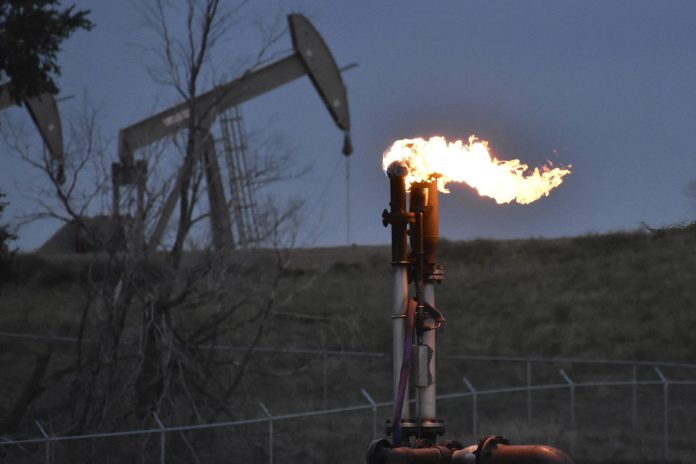
By MATTHEW DALY
The Associated Press
WASHINGTON The Biden administration issued a final rule Wednesday aimed at curbing methane leaks from oil and gas drilling on federal and tribal lands, its latest action to crack down on emissions of methane, a potent greenhouse gas that contributes significantly to global warming.
The rule issued by the Interior Department’s Bureau of Land Management will tighten limits on gas flaring on federal lands and require that energy companies improve methods to detect methane leaks that add to planet-warming greenhouse gas pollution.
The action follows a more comprehensive methane-reduction plan announced by the Environmental Protection Agency in December. The plan, announced at a global climate conference in the United Arab Emirates, targets emissions from existing oil and gas wells nationwide, rather than focusing only on new wells, as previous EPA regulations have done. It also regulates smaller wells that are now required to find and plug methane leaks.
Oil and gas production is the nation’s largest industrial source of methane, the primary component of natural gas, and is a key target for Biden as his administration seeks to combat climate change.
The rule issued Wednesday updates regulations that are more than 40 years old and will hold oil and gas companies accountable by requiring measures to avoid wasteful practices and to find and fix leaks, administration officials said. At the same time, officials said they are moving to ensure that American taxpayers and tribal mineral owners are fairly compensated through higher royalty payments imposed last year.
The final rule will help “prevent waste, protect our environment and ensure a fair return to American taxpayers,” Interior Secretary Deb Haaland said in a statement.
“By leveraging modern technology and best practices to reduce natural gas waste, we are taking long-overdue steps that will increase accountability for oil and gas operators and benefit energy communities now and for generations to come,” she said.
The rule is expected to prevent billions of cubic feet of natural gas from being wasted through venting, flaring and leaks, Haaland and other officials said.
Venting and flaring activity from oil and gas production on public lands has significantly increased in recent decades. Between 2010 and 2020, total volumes of natural gas lost to venting and flaring on federal and tribal lands averaged about 44.2 billion cubic feet per year — enough to serve roughly 675,000 homes, the Interior said. The figure represents a sharp increase from an annual average of 11 billion cubic feet lost to venting and flaring in the 1990s.
Environmental groups hailed the rule, calling methane a huge contributor to global warming.
“Strong Interior Department methane waste rules are integral for the United States to protect taxpayers from wasted energy resources,” said Jon Goldstein, senior director of regulatory and legislative affairs at the Environmental Defense Fund.
“Eliminating waste from routine venting and flaring of associated gas conserves domestic energy resources … lessens oil and gas production’s negative impact on the climate and protects the health of frontline communities,” said Tannis Fox, senior attorney at the Western Environmental Law Center, another environmental group.
The American Petroleum Institute, the top lobbying group for the oil and gas industry, called the new rule an overreach that could hamper U.S. energy production.
“API supports a smart regulatory framework for reducing methane emissions, but overlapping regulations and lack of coordination between policymakers could hinder progress, create unnecessary barriers to development on federal lands and result in regulatory incoherence,” said Holly Hopkins, an API vice president.
Arizona Rep. Raul Grijalva, the top Democrat on the House Natural Resources Committee, called the rule a “much-needed step” to fight climate change and protect the health of communities near drilling sites throughout the West.
“Big Oil and Gas have been getting away with sloppy operations for too long, without an ounce of regard for the destruction it’s causing,” Grijalva said. “I’m grateful the Biden administration is taking the bold action we need to hold fossil fuel facilities to a higher standard.”
Interior had previously announced a rule to restrict methane emissions under former President Barack Obama. The plan was challenged in court and later weakened under former President Donald Trump. Competing court rulings blocked enforcement of the Trump and Obama-era rules, leading the agency to revert to rules developed more than 40 years ago.
The rule would impose monthly limits on flaring and charge fees for flaring that exceeds those limits.
Besides the EPA rule, a 2022 climate law approved by Congress is set to impose a fee on energy producers that exceed a certain level of methane emissions. The fee, initially set at $900 per metric ton of methane, will mark the first time the federal government has directly imposed a tax on greenhouse gas emissions.
The climate law includes $1.5 billion in grants and other spending to improve monitoring and data collection of methane emissions, intending to find and repair natural gas leaks.



